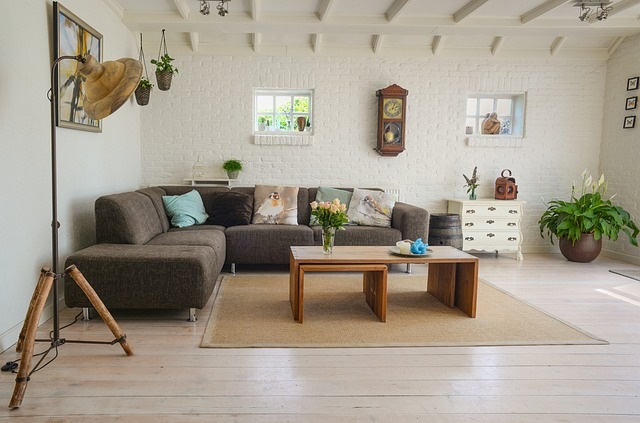Decorating your first apartment is an exciting feat, but it can also be a daunting process if you’re unsure where to begin. Now that you’ve left the dorm life behind, you can officially get rid of those stuffed toys, window blinds, and mini-fridge in the past. Presently, you’ve to identify your preferences and style your flat accordingly.
So, whether you’re someone seeking new apartments for sale in Dubai or for rental purposes, you’re on the right page. We’ve covered you, from low-profile tips to major makeover kicks. Let’s determine how you add a hint of “you” in every nook and cranny of your first apartment.
Entrance is the first thing visitors notice about your place, so let’s proceed with it. To your surprise, making it work with just a few stylish items is possible. For instance, hang two sculptural hooks for coats and bags and a slim basket for umbrellas. Next, you can place a chic accent chair for sliding in and out of the shoes, followed by a thin mirror that dresses up the wall for final touch-ups.
- Freshen Up the Living Room
Nothing uplifts a dull living room like a vase filled with vibrantly-fresh flowers. Even if you’re the only person to admire them, it’s an instant boost of positivity that will make you feel fresh after a tiresome day. You can make a bunch of your favourite flowers and organise them in an alignment.
Everything else goes in vain if there’s insufficient lighting in the room. So, if you’re up for warming up and personalising your flat while making it feel like home, there’re many ways. You can either opt for the side lamps or customise the windows by installing a modish sconce, which adds dimension to the walls and showcases a flattering light.
- Approach the Doors Universally
Many railroad apartments feature a middle and windowless room that connects all the rooms and relies on them for natural light. If you are conscious about your privacy but also need sunlight, figure out a way that doesn’t lead to the blockage of light and flow. In this regard, you can opt for glass sliding doors. They won’t block the sunlight, nor will they be sound-proofed, but you certainly get the extra hint of privacy.
If sliding doors isn’t your style, consider placing a wall-to-wall rod and hanging a separating curtain over it. In studio apartments, it’s a great way of dividing the areas where you can appear formally while the other one is to crash after an exhausting day.
A home is incomplete without a well-stocked kitchen. The bare essentials include cookware, a coffee machine, a toaster and a crockery, to name a few. If you’ve limited storage and can’t own it all, consider investing in beautifying your countertops with additional space.
The Takeaway
We can’t deny that moving into your first-ever apartment is a big deal, both physically and emotionally. And there’s certainly a lot to do. For this purpose, we suggest preparing a bucket list for all the factors you want to add to the premises as per your taste and budget and don’t forget to consider the ideas mentioned above when doing so.
Create a Budget
Personalization doesn’t have to break the bank. In fact, setting a budget is the first step in making your apartment uniquely yours. Knowing your financial boundaries allows you to get creative within those limits. Allocate funds for essential items and then set aside a budget for personalization. This ensures that you have the freedom to express yourself without compromising your financial stability.
Thrift Store Treasures
One person’s unwanted item is another’s treasure. Thrift stores are gold mines for unique, affordable finds. From quirky decorations to vintage furniture, you’ll be amazed at the gems waiting to be discovered. Shopping at thrift stores not only saves you money but also gives your apartment a distinctive charm that can’t be replicated with mass-produced items.
DIY Decor Projects
Unleash your creativity with do-it-yourself (DIY) decor projects. These projects not only add a personal touch to your space but also provide a sense of accomplishment. Whether it’s crafting your own wall art or repurposing furniture, the possibilities are endless. Plus, DIY projects are often budget-friendly, allowing you to personalize your apartment without breaking the bank.
Furniture Choices for Personalization
When selecting furniture, opt for pieces that serve a dual purpose—functional and stylish. Versatile furniture allows you to adapt your space as your needs and style evolve. Consider modular furniture that can be rearranged or multifunctional pieces that provide storage solutions. This way, your apartment remains adaptable to your changing lifestyle.
Express Yourself with Art
Art has the power to transform a space and convey your personality. You don’t need an extensive art collection to make an impact. Explore local artists, printables, or even create your own artwork. Framed pictures, paintings, or sculptures—whatever speaks to you can find a place in your apartment, turning it into a gallery of your life and interests.
Greenify Your Space
Bringing nature indoors is a timeless way to personalize your living space. Plants not only add a touch of greenery but also contribute to a healthier living environment. If you’re new to plant parenting, start with low-maintenance options like snake plants or succulents. The presence of plants creates a calming atmosphere, making your apartment feel like a true oasis.
Smart Storage Solutions
Organization is key to a personalized space. Smart storage solutions not only keep your apartment tidy but also add a decorative element. Consider storage ottomans, floating shelves, or stylish baskets that not only hide clutter but enhance the overall aesthetic. The more organized your space, the more it becomes a canvas for personalization.
Choose a Theme or Color Scheme
Giving your apartment a cohesive look ties everything together. Whether it’s a specific theme or a carefully chosen color scheme, having a unifying element brings harmony to your space. This doesn’t mean every item has to match perfectly; it’s about creating a visual flow that makes your apartment feel curated and intentional.
Personalized Lighting
Lighting sets the mood in any space. Experiment with different lighting fixtures to create ambiance. From string lights to floor lamps, the right lighting can transform your apartment into a cozy retreat. Consider smart bulbs for customizable lighting scenarios, allowing you to adapt the atmosphere to your mood.
Tech-Savvy Personalization
In the age of technology, infuse your apartment with smart home devices. From voice-activated assistants to smart thermostats, these gadgets not only add convenience but also a futuristic touch. Imagine adjusting your apartment’s temperature or playing your favorite music with a simple voice command. Embrace the future while personalizing your living space.
Entertain with Style
Make your apartment the go-to spot for gatherings by adding personal touches to your entertainment space. Whether it’s a stylish bar cart, cozy seating arrangements, or a curated playlist, infuse your personality into every corner. Create an inviting atmosphere that makes your guests feel at home, and your apartment becomes not just a living space but a social hub.
Stay True to Yourself
Amidst all the tips and tricks, the most important aspect of personalizing your first apartment is staying true to yourself. Your apartment should be a reflection of your personality, interests, and experiences. Don’t be afraid to showcase your quirks and individuality. The more authentic your space, the more it becomes a true extension of you.
Balancing Trends and Timelessness
While it’s tempting to follow the latest trends, strive for a balance between trendy elements and timeless pieces. Incorporating timeless elements ensures that your apartment won’t feel outdated as trends come and go. Choose classic furniture and decor items as a foundation, then sprinkle in trendy accessories that can be easily swapped out as styles evolve.
Conclusion
Personalizing your first apartment is a journey of self-discovery and creativity. It’s about turning a blank canvas into a living space that tells your story. Whether it’s through budget-friendly thrift store finds, DIY projects, or the integration of smart technology, each decision contributes to making your apartment uniquely yours. So, go ahead, express yourself, and turn your first apartment into a home that reflects the wonderful individual that you are.
FAQs
- How can I personalize my apartment on a tight budget?
- Explore thrift stores, embrace DIY projects, and prioritize budget-friendly decor options.
- What are some low-maintenance plants for beginners?
- Consider snake plants, pothos, and succulents for easy-to-care-for greenery.
- How do I balance trendy and timeless elements in my decor?
- Invest in classic furniture and add trendy accessories that can be easily replaced.
- Are there affordable smart home devices for apartment living?
- Yes, there are budget-friendly options for smart bulbs, plugs, and voice-activated assistants.
- How can I make my apartment more inviting for guests?
- Focus on creating a cozy and welcoming atmosphere with personal touches, comfortable seating, and entertaining essentials.

 Business1 year ago
Business1 year ago
 Tips & Tricks2 years ago
Tips & Tricks2 years ago
 Law1 year ago
Law1 year ago
 Technology2 years ago
Technology2 years ago
 Business2 years ago
Business2 years ago
 Lifestyle1 year ago
Lifestyle1 year ago
 Business1 year ago
Business1 year ago
 Tech1 year ago
Tech1 year ago







